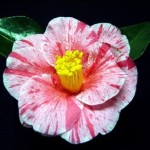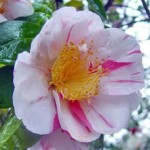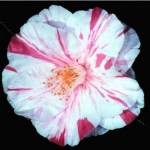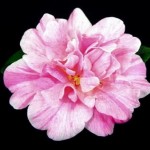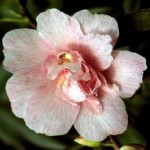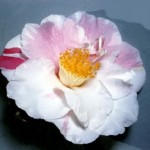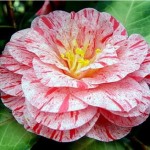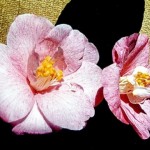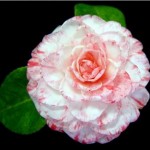by Kylie Waldon
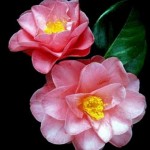
J. Edith Linton
What is it about striped camellias that makes so many camellians turn up their nose in disgust? Striped camellias, or striped flowers for that matter, were once considered quite regal and a much sought after commodity. Today, they seem to be the least favourite colour in camellias’, and of 670 or so Australian varieties still in existence, the humble striped camellia totals only around 50 cultivars’. That’s only about 7.5%!
There is not a camellia form that is not represented by a striped Australian camellia, nor a size limit; they range from miniature to very large. The list of originators of striped camellias is a who’s who’ of the camellia world, and the registrations are fairly continuous from 1848 to today. So what is there not to love about them?
Early striped camellias

J. Helenor
Of course, the earliest striped camellia is also one of our earliest known Australian camellias; C.japonica Helenor 1848, which is still very popular as a garden plant. Its midpink blooms are dashed and striped with darker pink, a lovely formal double (which sometimes opens to rose form double) and a tough bush.
Baptist & Son released C.japonica Iris 1848, C.japonica Miranda 1849, and C.japonica Lady Bowen 1864 which were white striped pink camellias. Miranda was an informal double Macarthur camellia; Lady Bowen was released by Guilfoyle. In fact, Guilfoyle bred a number of striped camellias between 1848 and 1880. C.japonica Miss Knox 1866 and C.japonica Lady Young 1871 (introduced by Baptist & Son) are both believed extinct.
C.japonica Brenda 1872, released by Shepherd & Co, was a red striped white formal double.

J. Aspasia Macarthur
Shepherd & Co followed with Guilfoyle’s C.japonica Mrs Fairfax in 1875, a white striped pink. Fuller’s of Sydney, introduced C.japonica Minnie Warren 1877, a Sheather camellia, which was salmon rose striped white. It is believed to be extinct. Shepherd & Son followed with two more striped camellias; C.japonica Mrs Hope 1880 a white striped red formal double, and C.japonica Ede 1884 which was deep rose, striped white in the centre. It is believed to be extinct. C.japonica Perdita 1886 is the last of the pre-1900 striped Australian camellias.
Originated at Camden Park it was later re-introduced by Waterhouse. Perdita is a red striped white formal double, originally described as ‘incurved’ like Myrtifolia. Perdita also throws a solid sport.
Striped camellias of the 1940s and 1950s
It is probably from this group that our best known striped Australian camellias appeared.

J. Jean Lyne
The first is one of the most prominent, as it continues through several prominently placed bushes at stately homes and Government buildings. The semidouble C.japonica Jean Lyne 1941 was introduced by Hazlewood Nursery, originating from Camellia Grove at Ashfield by way of G.C. Linton’s garden. It commonly sports its sisters, C.japonica Edith Linton and C.japonica Nancy Bird, which makes it very easy to identify.
Jean Lyne is white striped pink, and still sold in nurseries, though generally in NSW, where it is often also included as a named variety in show schedules.

J. Nancy Bird
C.japonica Minnie White 1944 was introduced and bred by Camellia Grove at Ashfield, and was described as a white formal double with ‘pink spots’, which is presumed to be striped.
C.japonica Glenronnae Brown 1945, a red striped white formal double, originated from the Melbourne Botanic Gardens as a ‘Guilfoyle seedling’ and was introduced by Hazlewood Nursery. In the same year, C.japonica Thompsonii (Australia) appeared, originated in a pot at Camden Park of unknown origin introduced also by Hazlewood Nursery, and described as a white flecked pink peony form. Camellia Grove introduced Waterhouse’s first striped camellia in 1946: C.japonica Lilian Pitts, a white striped red, single to semi-double, which also throws a solid sport (Lilian Pitts Rosea).
Although originated in the USA by EH Carter of California, Australia’s first striped sport came from a C.japonica Aspasia Macarthur plant in the USA, and was named C.japonica Strawberry Blonde. It is described as light salmon pink speckled deep pink. Her sport is C.japonica Glamour Girl.
Hazlewood Nursery introduced C.japonica Paul Jones 1949, a pink striped pink single to semi-double, which is also known for its sport, Roberta, and its seedling Paul Jones Supreme.

J. Paul Jones
C.japonica Paul Jones originated at Rookwood Cemetery. Hazlewood Nursery also introduced C.japonica Thomas Treseder 1949 a red striped white formal double. Two Waterhouse camellias followed in 1952: Cjaponica Andromeda (Waterhouse) and C.japonica Adrian Feint, both large white striped red semi-doubles. C.japonica Nancy Bird, a sport of C.japonica Jean Lyne, was also introduced in 1952 by Waterhouse.
C.japonica William Honey 1955 originated from Melbourne Botanic Gardens, and is an incomplete double, white striped pink. The pink striped red informal double C.japonica Edward Marsh 1956 was introduced by E Marsh of Victoria as a chance seedling. Also released in 1956, this time by Camellia Grove at St Ives, was the well-known C.japonica High Jinks, a white blotched sport of C.japonica Helenor Rosea and later often confused with C.japonica Tabbs, described unusually as a pink striped red with white blotches, formal double to rose form double.
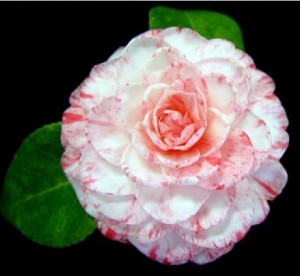
J. High Jinks
The last three striped camellias of the 1950s were all bred privately: C.japonica Clarissa (Turnbull) 1957 originated by Mrs H Turnbull of Victoria, a single pale pink with red stripes – a seedling of C.japonica Spencer’s Pink, C.japonica William Bartlett 1958 originated by Mr W Bartlett of Beecroft, NSW, a pale pink striped deeper pink formal double a seedling of C.japonica Jubilee Rosea (Mrs Scottowe), and the chance seedling C.japonica Del Rio 1959 originated by Mr G Hooper, NSW, a pink striped red informal double with a slight fragrance.
The 1960s
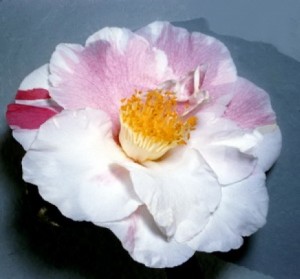
J. Helen Calcutt
For the striped camellias, the 1960s proved to be a harsh decade, for although 11 striped camellias were registered, few are commonly available or even sighted today. C.japonica Helen Calcutt 1960 is the first of these, bred by Mr K Brushfield, NSW, a white striped red single to senii-double, which throws two sports; a solid and a pink with a white border. Four striped camellias were registered in 1962; the two Waterhouse camellias released by Eagle Heights Nursery, Qld – C.japonica St Ives, a white striped and blushed pink informal double, and C.japonica Corroboree, a seedling of C.japonica Tricolor, a white striped red semi-double.
C.japonica Ann Shaw originated by Mrs Shaw, NSW, a white striped pink peony form, and C.japonica Deeten originated by Taylor & Sangster Nursery and introduced by E G Waterhouse, NSW, a large white striped red semi- double, were also registered in 1962.
C.japonica Beryl Hebiton 1963 was the first striped camellia bred in Western Australia, a pink striped pink informal to incomplete double, registered by W Hebiton. It was a seedling of C.japonica Hikarugenji or C.japonica Lady Loch. C.japonica Churston 1963 was originated by Mrs J Anderson, Vic, a pale pink striped red single with wavy, cupped petals.
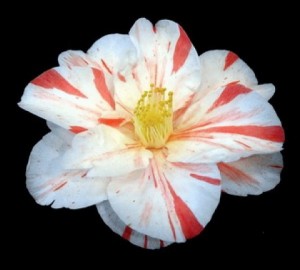
J. Paul Jones Supreme
C.japonica Julia’s Wish 1964 was originated by J.C. Scott Waine of Warrawee, NSW, a white informal double with an occasional pink stripe or fleck, believed to be a seedling of C.japonica Gauntletti or C.japonica Shiragiku. A seedling of C.japonica Odoratissima, C.japonica Lilian Burgess 1965 was originated by Peggy Waring of Kenmore, Qld, described as a white incomplete double splashed and striped pink, and also fragrant. Eagle Heights Nursery in Qld introduced Waterhouse’s C.japonica Candy Stripe (Waterhouse) 1965, a seedling of C.japonica Doris Hirst, described as a slightly fragrant, white striped red single.
The best known of the group is probably C.japonica Paul Jones Supreme 1968, a seedling of C.japonica Paul Jones, bred by Waterhouse, described as a large semi-double, white striped pink and red.
The 1970s
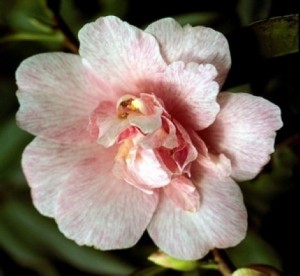
J. Lollypop
Up to the 1970s, there were no other striped camellias bred in Australia except japonicas or sports of japonicas. In the 1970s two hybrids were finally bred, but generally striped camellias have only come from the japonica stable. A seedling of C.hybrid Cornish Snow was the first striped camellia of the 1970s. Bred by Mr Fred Tuckfield, Vic, C. hybrid Lollypop 1971 would be one of the most interesting crosses in striped camellias. The flower was a miniature, pale pink with pink flecking, single, often with petaloids or petals in the centre. Mr F Tuckfield also produced an interesting seedling of C.japonica Great Eastern: C.japonica Courtesan 1971, a small pink striped red informal double which also produces a solid sport.
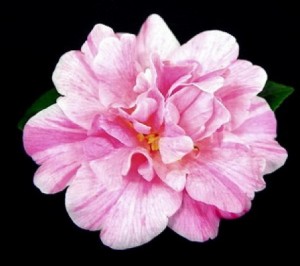
H. Gay Pixie
In 1974, four japonica camellias were introduced by Hazlewood & Jessep that were not previously recorded: Edward Marsh Variegated, a variegated sport of the striped informal Edward Marsh, Early Striped Ball a white striped pink informal double, Jean Galbraith, a white striped pink single with a solid pink sport (Jean Galbraith Rosea) and Countess a white to pink, striped red. In 1975, C.japonica Robert Henty (a sport of C.japonica Charles Henty) was introduced, described as white striped pink. Sebire’s C.hybrid Gay Pixie was registered in 1979, a seedling of C. Pitardii var. Pitardii, incomplete double, light pink striped darker pink, 11 cm across. The only non-japonica striped Australian camellias (to 1994) arc H. Gay Pixie and H. Lollypop, both bred by Victorians.
1980s & beyond

J. Williamina Soper
C.japonica Williamina Soper, 1980, was registered by Graeme Oke, NSW, a seedling of Celtic Rosea. The formal double, pink striped darker pink with incurved centre petals was described as 9 cm across. A C.sasanqua Onigoromo seedling, Coconut Ice, appeared in the same year, registered by A Spragg, NSW; described as a pink striped white single, it measures just 7 cm across. Two striped camellias were registered in 1982; C.japonica Adelina Sargeant a pink striped pink single to semi-double, and C.japonica Flashlight, which originated from E G Waterhouse, a white striped red single.
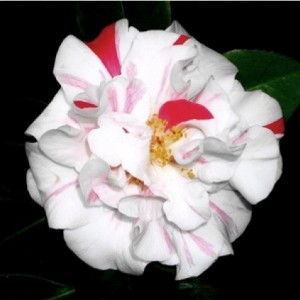
J. Flashdance
C.japonica Cho Cho San brought us two Australian camellias; in 1983 it was the striped C.japonica Rowena Craig, registered by E Craig, NSW, a white striped red single, with cup to tulip shaped flowers. Also in 1983, T Savige, NSW, introduced C.japonica Nicole, a formal to informal double pink striped red with heavy texture.
In 1987 C.japonica Alice Morgan was registered by A Morgan, NSW, described as a white striped red, anemone form. In 1989, D Coe, NSW, registered C.japonica Flashdance; a seedling of C.japonica Tiffany, a white striped red semi-double to peony form which is often seen on the show benches in the Hume area..
.
- J. Edith Linton
- J. Paul Jones Supreme
- J. Flashdance
- J. Corroboree
- J. Adrian Feint
- J. Paul Jones
- H. Gay Pixie
- J. Nancy Bird
- J. Ann Shaw
- S. Dr. Frankenfurter
- J. Strawberry Blonde
- J. Edward Marsh
- J. Lollypop
- J. Williamina Soper
- J. Courtesan Var.
- J. Helen Calcutt
- J. Helenor
- J. William Honey
- J. Nicole
- J. Jean Lyne
- J. Coconut Ice
- J. High Jinks
- J. Robert Henty
- J. Aspasia Macarthur
The information in the above article was based on the International Camellia Register only. It did not include any of the late registrations or corrections that appeared in the later Supplement. This included Pale Opal, Donna Rita, and Fairy Floss. Bright Eyes was also not in the Register as it was listed as Bright Forecast in error (Bright Forecast had two entries) but this error was mentioned in the Supplement. May Avard is listed in the Register as originated by Mrs May Avard of Emerald in Victoria and includes its breeding, and is not attributed to Sebire (it still might be one that he registered on her behalf). Wendy Gaye is one of those unusual camellias; it originated from Huntington Garden seed from the USA, and although raised and registered by Sebire, it originated in the USA. National Registrar Ray Garnett has advised me that sports of camellias that orignated in other countries, and foreign seed raised in Australia, would not be fully recognised as ‘Australian’ camellias. I guess there would be a lot of debate on this point. It was omitted for that reason.
References
1. Australia’s Favourite Camellias in 2000 Survey – K Waldon
2. International Camellia Register Vols 1 & Vol 2, 1999 (camellias to 1994)
J. Coconut Ice



